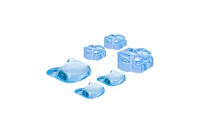RESION epoxy casting resin



- Crystal clear casting up to 3 cm
- No odour / solvent-free
- 45 min. processing time
To create resin or epoxy art, you need the right synthetic resin. Because of its easy application, RESION epoxy casting resin is often used for this purpose. This product consists of a transparent 2-component casting system and can be coloured with various pigments. As this type of synthetic resin is also suitable for castings up to 3 cm thick, this material is also very suitable for tabletops or even floors, for example.
How to use synthetic resin
This type of synthetic resin consists of an epoxy resin plus hardener, which you need to mix before starting. To do this, use a scale and mix both components carefully. If necessary, use the 2-cup mixing method to make sure the epoxy is completely mixed.
Benefits of RESION epoxy casting resin
- Solvent-free.
- Does not/barely smell.
- Very good UV resistance.
- With our UV stabiliser you can even use epoxy casting resin outdoors without discolouration.
- Can be poured up to 3 cm thick.
- Can be poured in several layers on top of each other.
- Very clear end result.
- High scratch resistance and protection.
- Levels out smoothly.
- Adheres to almost all substrates (wood, concrete, plastic etc).
- Can be coloured with a pigment of your choice.
- Hardener is included.
For optimal results, use the resin art starter pack from Polyestershoppen! Here you will find all the materials you need to create the most beautiful works of art.
Specifications
Contents: 0.8 kg, 1.6 kg, 8 kg, 16 kg, 32 kg, 64 kg (sets of epoxy resin and hardener)
Mixing ratio: 100:60 (100 grams of resin, 60 grams of hardener)
Processing time: 30 to 60 minutes (20℃)
Dust dry after: approx. 6-12 hours (20℃)
Handleable after: 12-18 hours (20℃)
Minimum processing temperature: 12℃
Full cure: 3-5 days
Shelf life: 1 year (at 15-20℃ and stored in the dark)
All proportions in a diagram? Check our Mixing schedule epoxy resin (100:60)
We have a number of recommendations for working safely with polymers. At Polyestershoppen you will not only find the polymers themselves, but you can also purchase all the protective equipment you need from us. If you have any doubts or questions, please contact our customer service. We can give you advice on how to work safely with polymers.
- Epoxy for Beginners
- Coating Table Tops and Bar Tops with Epoxy
- Mixing ratios and mixing of Epoxy and Polyester
- Personal Protective Equipment When Working with Resins
- Overview of Casting Resins
- DIY Epoxy Table: How to Make a Smarties Table
- DIY | How to Make Your Own Orgonite
- DIY | Make Your Own Resin Art Clocks
- DIY | Making a Coin Floor
- Epoxy Side Table with Wood and Glow in the Dark
- How Much Epoxy Do You Need?
- Successful Epoxy Casting? Avoid These 10 Mistakes!
- How Well Does Epoxy Resist UV Light?
- FAQ - Working Safely With Epoxy
- The Temperature Resistance of Epoxy
- Troubleshooter: Epoxy Resin
- Mixing Epoxy Using the 2-Cup Method
- What Is the Difference Between Epoxy and Polyester?
- Everything You Need to Know About Amine Blush: The Invisible Enemy of Epoxy Resin





